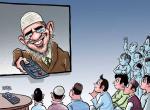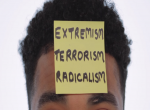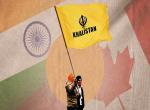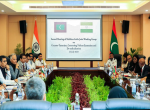The Chambers Twenty-first Century Dictionary defines ‘preempt’ in the following words:- “To do something ahead of someone else and so make pointless an action they have planned”. Preemptive action is defined by the same dictionary as an attack “effectively destroying the enemy’s weapons before they can be used”.
Preemptive action, therefore, is likely to be resorted to in a warlike situation where it is necessary, in fact vital, to destroy the enemy’s capacity to attack and thereby ensure victory. Under what conditions would the police be allowed preemptive action, which could include destruction of property and causing the death of persons who can be identified as inimical to the national interests?
One of the main differences between the military and the police is that the armed forces have an identified enemy and their objective, in the defence of the country, is to destroy the enemy’s offensive capabilities and to inflict such casualties on the enemy as would make it impossible for him to pose a threat to national security and the territorial integrity of the country. The dictionary meaning of the military is “the armed forces, maintained for the purpose of warfare”. The police, on the other hand, is defined as “a body of men and women employed by the government of a country to keep order, enforce the law, prevent crime, etc”. The armed forces are generally required to act against an external enemy, whereas the police is required to maintain order within the country and, therefore, largely deals with Indian citizens. Under section 23 of the Police Act, amongst the duties of a police officer is to prevent the commission of offences and public nuisances. In order that he may be able to perform his duty, Chapter XI, Criminal Procedure Code (Cr.P.C.) authorises the police to take preventive action under section 149 to ensure that cognisable offences are not committed. Under section 151, Cr.P.C. the police has the authority to arrest a person about whom it has information that he has a design to commit a cognisable offence. The police, therefore, has the legal authority to preempt the commission of a cognisable offence, intervene and take action against any person about whom it has information regarding a design to commit such an offence. To the extent that it preempts an attack to commit an offence such preventive action is also a form of preemptive action.
Coming to Chapter X, Cr.P.C. dealing with maintenance of public order and tranquility, an Executive Magistrate who comes across an assembly of five or more persons which intends to cause a disturbance of the public peace and is thereby an unlawful assembly, can command it to disperse and on its failure to do so can order the use of necessary force, which may include the use of lethal force. This, too, is a form of means of preempting any action by such assembly which could result in break-down of law and order. In continuation of the same authority to prevent disturbance of public peace, an Executive Magistrate may issue an order under section 144, Cr.P.C. directing the person or persons to abstain from certain acts and in order to enforce the order the Magistrate can take such action as may be necessary. This precautionary measure is also a form of preemption because it does result in preventing an offence or disturbance of public peace from occurring.
The scheme of the law is that preventive action is not only permissible, but is also mandated so that public order is maintained and crime prevented. At one level, this mandate is similar to that of the armed forces, that is, to ensure safety and security. But there are differences also and in this regard, the Police Manual drawn up under the Police Act, the Internal Defence and Internal Security Schemes which state what is to be done if the country is facing either a major internal security crisis or an external threat, lay down the procedures, the duties, etc., of the police, the magistracy and the armed forces. However, the doctrine so far as the police is concerned is the use of minimum force, which means minimum effective force, when dealing with a situation pertaining to law and order or general crime. So far as the armed forces are concerned, when facing an enemy, which means an external enemy, the maxim would be to use maximum effective force which would inflict crippling casualties on the enemy while minimising one’s own casualties. Thus, preventive or preemptive action by the police would be measured and aimed at achieving the desired objective without inflicting unnecessary damage or casualties. Preventive action by the armed force would be aimed at causing the maximum damage and maximum casualties to the enemy. The police is governed by the laws of India which naturally place the citizen above everything else. The armed forces are governed by the rules of war in which India comes first and destruction of the enemy is the main objective. Obviously, the police cannot adopt military tactics when dealing with a law and order situation.
The use of force, including lethal force, is legitimate for the police, but strictly as permitted by law. For example, under Chapter V,Cr.P.C, when making an arrest, the police may use force if such an arrest is resisted. Section 46, Cr.P.C. states how an arrest may be made. However, whereas under section 46(2), a police officer or any other person making an arrest may use force, this cannot extend to the causing of death of the person to be arrested unless he is charged with an offence punishable with death or with imprisonment for life. In that case, of course, the arresting officer, in order to overpower the accused, can cause death if the circumstance warrants it. A person who voluntarily surrenders cannot be subjected to the use of force. Of course, under the Geneva Convention, even in a war if an enemy surrenders, he has to be treated with courtesy and he cannot be put to death. Killing a surrendered enemy is an offence defined as a war crime.
In the maintenance of public order under the directions of the Executive Magistrate or a police officer, when dispersing an unlawful assembly, both civil and military force can be used. Even when using military force to disperse an unlawful assembly, the armed forces will act on the requisition of an Executive Magistrate, but in doing so, “the commanding officer shall use as little force and do as little injury to person and property as may be consistent with dispersing the assembly and arrest and detaining such person”. The use of minimum force, therefore, is the doctrine for both the police and the armed forces when dealing with assemblies of citizens which may have become unlawful. The action is preventive, but the preemptive portion of it is subject to the principle of use of minimum force.
Unfortunately in India, the choice is not always between civil action and military action because there are shades and nuances of crimes and criminals which one does not find in many other democratic countries where there is the rule of law. Britain is one such a country, but here, too, when faced with an insurgency situation in Ulster, a section of the British police force, designated as the Royal Ulster Constabulary (RUC), was organised as an armed police with paramilitary functions. Even though the principle of use of minimum force continued to apply, the RUC carried out preemptive strikes against the terrorist outfit, the Irish Republican Army (IRA) and where it came to an armed encounter, the RUC did not hesitate to use its weapons to neutralise or even liquidate the militants. Whereas the rules of war did not apply, nor did the normal doctrine of policing when faced with a situation of armed conflict. In India, the police is faced with a whole series of situations in which the civil affairs exist side by side with crimes like dacoity in which armed gangs of five or more people come together in order to loot people and do not hesitate to use their fire arms, militancy which has a political objective, outright insurgency as in Nagaland, Manipur, etc., separatism and terrorism as in Kashmir and a state of near civil war as is found in the Naxalite affected areas. In the last named areas, we have whole districts where civil government has virtually ceased to exist and armed police units have to be deployed in a warlike situation. The Naxalites use ambush as a favourite tactic, they use mines and improvised explosive devices to cause blasts which blow up vehicles and kill or injure large numbers of policemen, they have automatic weapons, they are experts in use of terrain and guerilla tactics and they inflict heavy casualties on the police. In such a situation the laws, rules and procedures which govern the civil police just cannot apply. Whereas in a normal situation the right of private defence is valid only if there is an imminent danger to life and property, in an insurgency type of situation, the right of private defence extends to attacking the insurgents before they attack the security forces. This is preemptive action and where it is not undertaken, ambushes can occur such as the one which killed 76 CRPF personnel in one strike and another which virtually decimated the Congress leadership in Chhattisgarh. Here the tracking down of Naxalites, finding their hideouts and then attacking them in order to neutralise groups of militants is absolutely legitimate, viable and valid. The benchmark governing police action in a normal situation will not apply here. When dealing with militants and Naxalites whose objective is to weaken the Indian State by targeting security forces and government officials, we have to lay down different methods, though always within the confines of law.
There is another area where terrorists, many of them supported by government and nongovernment agencies in Pakistan, commit acts of terror in India. The 1993 bomb blasts in Mumbai, the 2008 attack, again in Mumbai, bomb blasts at different times in Delhi, the German Bakery case in Pune, to quote just a few examples, are terrorist acts in which the objective is to spread fear in India. How does one deal with such cases? A terrorist submerges himself in society and at the appropriate time when the risk of detection is minimum, he strikes. If he has struck, nothing can be done to stop this and, therefore, it is only by intelligence gatherings that one can get an inkling of new terrorist strikes which might have been planned. Here the only way to stop the terrorist is to strike him before he can act. One does not want to comment on the Sohrabuddin case and the Ishrat Jahan case because the courts have taken cognisance in both cases, but one cannot rule out the possibility of the Gujarat Police having made preemptive strikes which seem to have paid off because Gujarat is relatively free of terrorist activity.
This is really a grey area. If R&AW were to arrange a bomb blast in Karachi which buries Dawood Ibrahim under the rubble of his own house, it would be hailed as a successful preemptive strike. The same action against a known terrorist or criminal in Mumbai or Ahmedabad might invite a charge of murder against the Maharashtra or Gujarat Police. Where does one draw the line? Let us at least be aware of the fact that this nation is under attack by terrorist organisations based in Pakistan, there is real fear of possible militant activity which might erupt if Afghanistan goes the Taliban way, there is insurgency of the Naxalite kind which has seriously undermined the authority of government in large parts of India and there is a degree of extremism, which threatens public order and public safety, all of which need to be countered. If we accept such activity to be anti terrorist, then there will be an element of preemptive action.
We have to develop the capability of distinguishing between preventive action under normal circumstances which is perfectly legal, preemptive action under certain other circumstances which may be on the border line but still compatible with civil norms and yet another set of actions in which the war is carried proactively to those elements which are trying to destroy our national fabric. Here the rules of engagement will have to be different in order that the security forces, operating under great handicaps, would be given a fair chance to take on and neutralise those who are trying to damage India. In other words, we would have to draw up fresh rules of engagement which permit preemptive strikes, avoid civilian casualties so that innocents are not caught in the cross fire and yet effectively neutralise anti national forces. The drawing up of the new guidelines is the real challenge for the Ministry of Home Affairs, the Intelligence Bureau, the Research & Analysis Wing and the National Security Adviser.
Published Date: 22nd July 2013, Image Source: http://upload.wikimedia.org









Post new comment